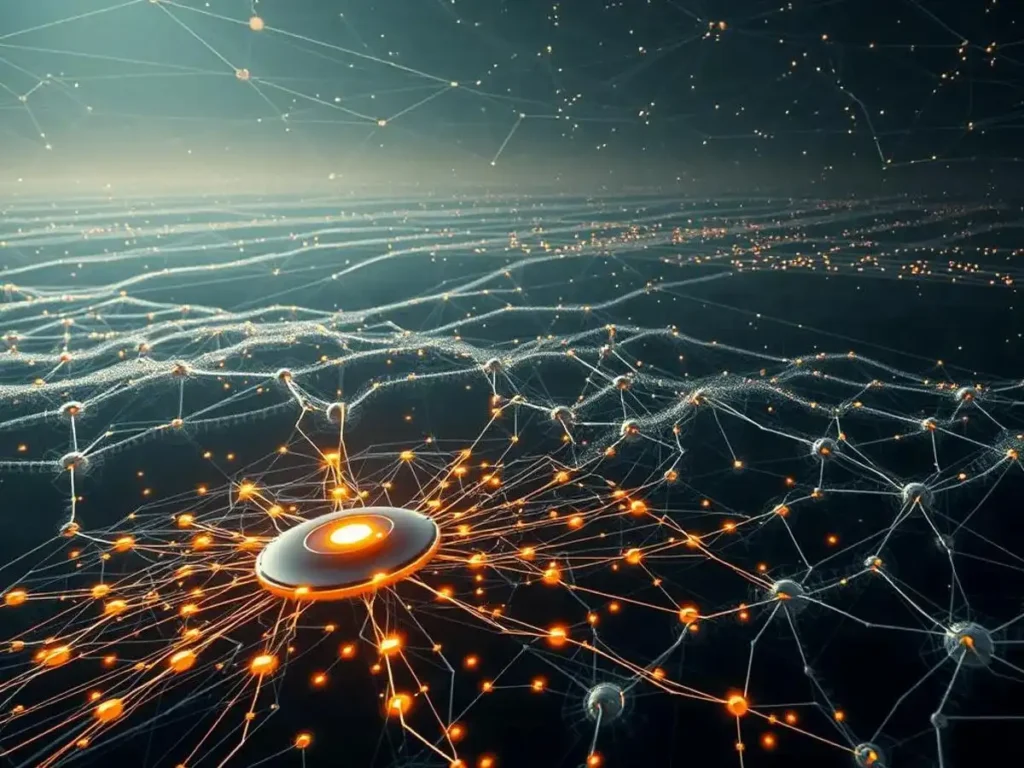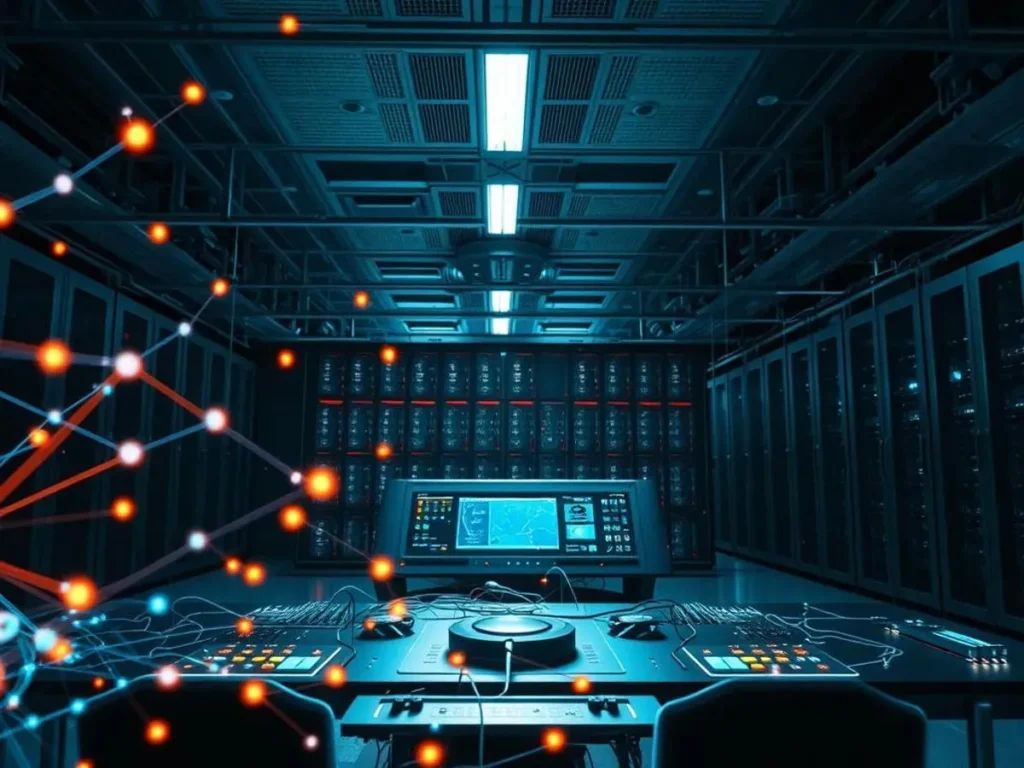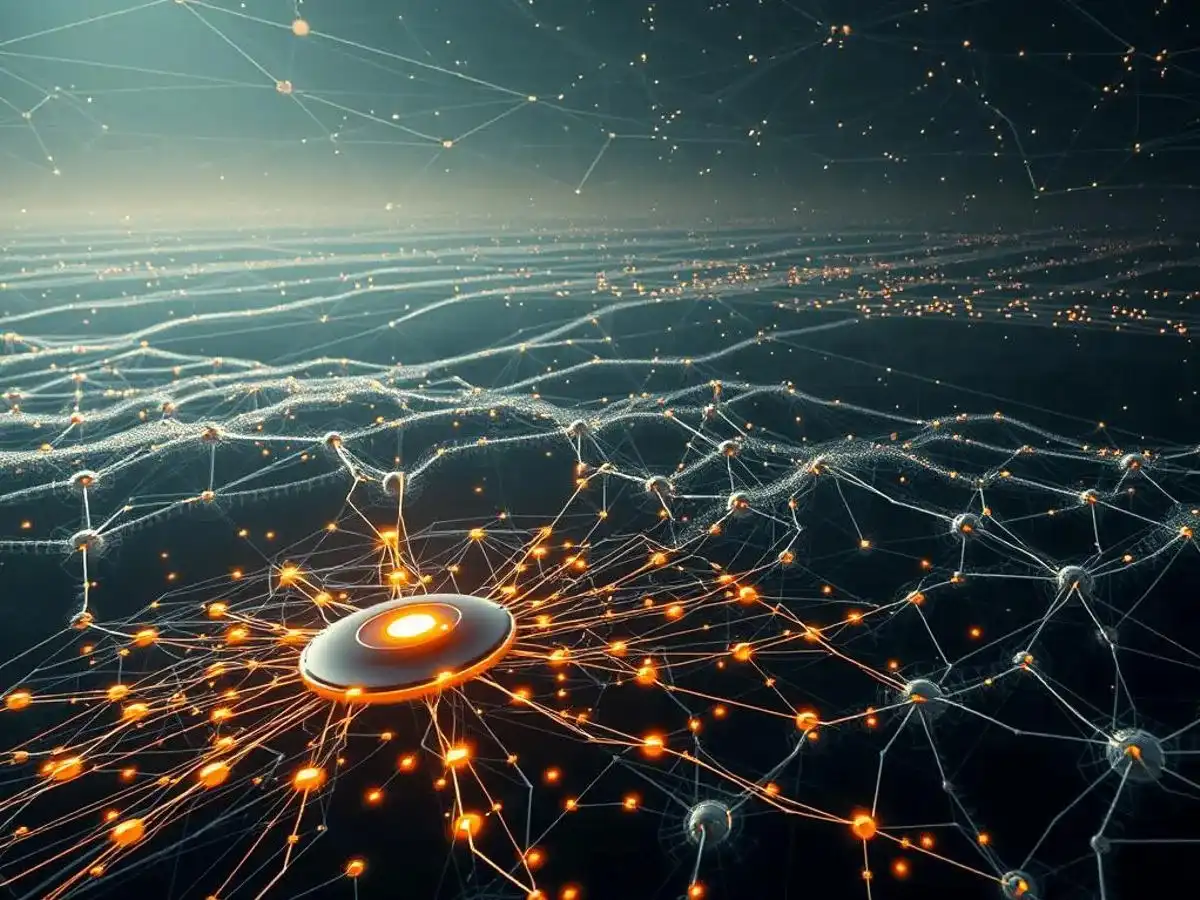
Every day, neural networks in artificial intelligence process over 45,000 years of human knowledge in just one second. This is a huge leap in technology, driving breakthroughs in many areas.
These networks let machines learn, adapt, and solve problems like humans. They help diagnose diseases and predict climate patterns. Their impact is huge and keeps growing.
We look at how these systems change technology, business, and our daily lives. We dive into the science behind their success. And we see the future they’re building, where AI and human innovation work together perfectly.
Introduction to Neural Networks in Artificial Intelligence
Neural networks are like tiny brains in computers. They help AI systems learn from data without needing to be programmed. Deep learning, a type of neural network, is key to big advances in healthcare and finance.
- Input layers receive raw data (e.g., images, text)
- Hidden layers process information through weighted connections
- Output layers generate predictions or classifications
| Component | Function |
|---|---|
| Input Layer | Accepts data like images or sensor readings |
| Hidden Layers | Analyze patterns through multiple processing stages |
| Output Layer | Returns final decisions or insights |
Deep learning is great at things like face recognition and language translation. These networks get better with practice, adjusting their connections as they learn. For instance, a self-driving car uses deep learning to read road signs.
Foundations of Neural Networks and Deep Learning
Exploring the roots of neural networks shows how machine learning has grown into a key technology. This part looks at major steps and the science behind them.
Historical Overview
The story started in the 1940s with early models of artificial neurons. In 1958, Frank Rosenblatt created the perceptron, a key for recognizing patterns. Though faced with challenges, the 1980s saw a comeback with the backpropagation algorithm. By the 2010s, better computers and more data made machine learning thrive, leading to big wins like ImageNet’s 2012 image recognition achievement.
Core Principles
Neural networks are based on three main ideas:
| Concept | Description |
|---|---|
| Backpropagation | An algorithm adjusting connection strengths to reduce prediction errors. |
| Activation Functions | Mathematical rules determining neuron activation, like ReLU or sigmoid. |
| Layer Architecture | Input, hidden, and output layers process data through interconnected nodes. |
These ideas help machine learning models dig into big datasets and find hidden patterns. Knowing these basics opens up AI’s possibilities in many fields.
Exploring Machine Learning and AI Algorithms
Machine learning and AI algorithms are at the heart of artificial neural networks. They are the brains behind tasks like recognizing images and analyzing data. This lets artificial neural networks learn from patterns in data.
There are three main ways these systems work:
- Supervised learning: This method teaches artificial neural networks using labeled data. It helps them make predictions.
- Unsupervised learning: It finds hidden trends in data without labels. This makes artificial neural networks more flexible.
- Reinforcement learning: It uses rewards to improve decisions. This boosts artificial neural networks in changing situations.
These methods tackle real-world problems. In healthcare, they spot diseases from scans. In finance, they forecast stock trends by looking at market data. Each type of algorithm makes artificial neural networks better at solving problems.
Keeping algorithms up to date keeps artificial neural networks sharp. By using these tools together, we create smarter systems. These systems learn, adapt, and solve problems accurately in many fields.
Diving into Artificial Neural Networks: Models and Frameworks
Creating effective neural networks begins with picking the right model and framework. The model’s architecture determines how AI algorithms handle data, whether it’s images or text. Frameworks help by providing tools for building, training, and deploying models.

Significance of Model Architecture
Model architecture is key to a neural network’s success. It defines the network’s structure and what it can do. For instance:
- Convolutional Neural Networks (CNNs) are great for analyzing images and videos.
- Recurrent Neural Networks (RNNs) work well with sequential data like speech or time-series data.
- Transformer models lead in natural language processing (NLP) tasks today.
Choosing the right architecture is vital. It ensures AI algorithms meet specific needs, balancing speed, accuracy, and resource use.
Popular Frameworks in AI
Frameworks offer the tools to build neural networks. Here are some top ones:
| Framework | Key Features | Use Cases |
|---|---|---|
| TensorFlow | Scalable, supports distributed training | Large-scale production systems |
| PyTorch | Dynamic computation graphs, user-friendly | Research and prototyping |
| Keras | High-level API for simplicity | Accelerating model development |
| Microsoft’s CNTK | Efficient for speech and text processing | Enterprise deployments |
These tools help developers test and deploy AI algorithms. They make advanced AI available to businesses and researchers.
Understanding Neural Network Applications in Modern Technology
Neural network models are changing industries in big ways. They can handle huge amounts of data and learn from it. This makes them key players in innovation.
Real-World Use Cases
These systems solve many problems:
- Healthcare: They look at medical images to find diseases like cancer quickly and accurately.
- Finance: Banks use them to spot fake transactions fast.
- Automotive: Tesla uses them to make self-driving cars better by analyzing data in real time.
Impact on Industries
Industries are seeing big changes:
- Healthcare: They help find diseases faster and find new drugs quicker.
- Finance: They make security better and help spot risks automatically.
- Automotive: They help make cars drive themselves and manage traffic better.
The Role of Deep Learning in Advancing AI
Deep learning is a key part of AI that makes big leaps by using pattern recognition on a huge scale. It has layers of neural networks that go through lots of data. This helps systems learn and get better on their own.

- Convolutional neural networks (CNNs) for image analysis
- Recurrent neural networks (RNNs) for sequential data
- Generative adversarial networks (GANs) for synthetic data creation
| Approach | Pattern Recognition Strengths | Applications |
|---|---|---|
| Traditional ML | Requires manual feature selection | Basic classification tasks |
| Deep Learning | Automates feature extraction | Medical imaging, fraud detection |
Tools like TensorFlow and PyTorch help developers make systems that find cancer in scans or guess market trends. These models improve with more data, creating a cycle that boosts pattern recognition. From self-driving cars to voice assistants, deep learning tackles tough problems. It moves from fixed rules to learning from experience.
Enhancing Pattern Recognition with Neural Networks
Neural networks are changing how we solve complex pattern recognition problems. They use better algorithms and data methods. This makes them spot trends in big datasets more accurately than before.
Techniques and Strategies
Some key strategies include:
- Convolutional neural networks (CNNs) for image analysis
- Recurrent neural networks (RNNs) to process sequential data
- Data augmentation to improve training datasets
Case Studies
Real-world examples show how well they work:
| Industry | Application | Outcome |
|---|---|---|
| Healthcare | Cancer diagnosis through medical imaging analysis | 95% accuracy in tumor detection |
| Finance | Fraud detection in transaction patterns | 80% reduction in false positives |
These examples show how neural networks improve with techniques like layer optimization. They also reduce data bias. This helps them work better in changing situations.
Integrating Machine Learning for Smarter AI Development
At the heart of modern AI development is the mix of machine learning (ML) and neural network engineering. This blend lets systems learn, adapt, and get better on their own. It leads to big leaps in solving problems and making decisions.
By mixing ML algorithms with neural networks, developers make AI that grows with user needs. This is how AI gets smarter and more useful over time.
- Data-driven training cycles refine algorithms through real-world feedback loops
- Iterative testing ensures models adapt to new data patterns
- Hybrid frameworks merge ML techniques with deep learning for optimal performance
Tools like TensorFlow and PyTorch make it easy to work together. They help teams build big, working solutions. Working together, data scientists, engineers, and experts make AI better for different fields.
For example, healthcare uses ML to look at medical images quickly. This makes doctors more accurate in their diagnoses.

We focus on using AI in real ways. We test models in safe places before they go live. This way, we avoid big problems.
These steps are changing finance, logistics, and customer service. As AI development keeps growing, working together will be key to making AI even better.
Unlocking the Future with Neural Network Technology
New trends in neural network technology are changing what’s possible. Advances in quantum computing and edge AI are making systems faster and more efficient. These changes will lead to smarter solutions in many fields.
Emerging Trends
- Quantum neural networks merging with classical systems
- Edge computing enables real-time data processing
- Hybrid models blending symbolic AI with deep learning
Future Possibilities
Picture a future where healthcare can diagnose diseases with 99% accuracy. Or where self-driving cars can avoid dangers milliseconds before they happen. Neural network technology could make these dreams a reality. Here are some areas to watch:
- Personalized medicine through predictive analytics
- Climate modeling for precise environmental forecasting
- Autonomous supply chains optimizing global logistics
As research speeds up, the chance for big changes grows. Discoveries in this area will keep changing how we use technology. They will also help solve big global problems.
Ethical Considerations in the Age of AI and Neural Networks
Neural networks are changing many industries, raising big ethical questions. We need to think about privacy when we handle huge amounts of data. How can we keep moving forward with new tech while protecting our info?
- Privacy: Keeping data safe is key. Laws like GDPR help, but we must follow them closely.
- Bias Mitigation: Datasets with biases can lead to unfair results. We need to check our algorithms to make sure they’re fair in things like hiring and lending.
- Transparency: AI systems should explain their choices. Users need to understand why they got certain recommendations.
- Accountability: The people who make AI tools must own up to any problems they cause.
Setting ethical rules now will shape AI’s future. By focusing on human values, we can make sure tech grows in a good way. Let’s create systems that are both strong and fair.
Collaborative Innovations Driving AI Progress
We’ve seen how working together is changing industries. Companies and researchers team up to make big leaps. This teamwork is key to pushing AI forward.
Industry Partnerships
Some major partnerships include:
- Google and NVIDIA: Making AI training better
- Tesla and AMD: Improving self-driving car tech
- Microsoft and OpenAI: Boosting large language models
Research and Development
Here are some academic-industry teams:
- IBM and MIT: Using quantum computing for AI
- Stanford’s work with healthcare firms: Creating AI diagnostics
- University of Toronto and NVIDIA: Advancing image recognition
These partnerships bring together different skills. They turn research into practical solutions. By sharing knowledge, they make sure AI keeps getting smarter.
Conclusion
Neural networks and artificial intelligence are changing how technology meets society. They help solve big problems in healthcare and make systems work on their own. These advances rely on deep learning and recognizing patterns, leading to new ideas in many fields.
As AI gets better, it’s important to think about ethics and work together. Tools like TensorFlow and PyTorch help developers, while big companies like NVIDIA and Google push the boundaries. We need to make sure AI helps everyone without hurting privacy or fairness.
The future looks bright with AI helping in many areas. It will make our lives easier and more personalized. By keeping up and participating, we can help AI grow in a way that’s good for everyone.
Table of Contents
FAQ
What are neural networks in artificial intelligence?
Neural networks are like the brains of computers. They have nodes that work together to learn and make decisions. This makes them key to deep learning, helping machines learn on their own and changing many industries.
What are some common applications of neural networks?
Neural networks are used in many ways. They help with recognizing images and speech, making medical diagnoses, predicting the stock market, and even driving cars on their own. Their ability to learn from data makes them very useful in AI.
How do we train a neural network model?
Training a neural network means feeding it lots of data and adjusting its connections. An algorithm called backpropagation helps figure out how to make the model better. We keep tweaking the connections until the model’s guesses are very close to the real answers.
What are some popular frameworks for building neural networks?
TensorFlow, PyTorch, and Keras are the top choices for making neural networks. These tools make it easier to design, train, and use neural networks. They help AI work in many different areas.
What role does pattern recognition play in AI?
Pattern recognition is key for AI. It lets machines spot and sort data patterns well. This makes AI better at making predictions and finding insights in big data. It’s very useful in healthcare, finance, and marketing.
What ethical considerations should we take into account with AI?
When making AI, we need to think about privacy, bias, and how decisions are made. As we use AI more, we must make sure it’s fair, accountable, and used responsibly.
How can neural networks evolve in the future?
Neural networks are set to get even better. They might learn without needing to be told what to do, understand things better, and work faster. As AI gets smarter, neural networks will be able to solve harder problems in many fields.


I appreciate you sharing this blog post. Thanks Again. Cool.
For the reason that the admin of this site is working, no uncertainty very quickly it will be renowned, due to its quality contents.
This was beautiful Admin. Thank you for your reflections.
I like the efforts you have put in this, regards for all the great content.
For the reason that the admin of this site is working, no uncertainty very quickly it will be renowned, due to its quality contents.